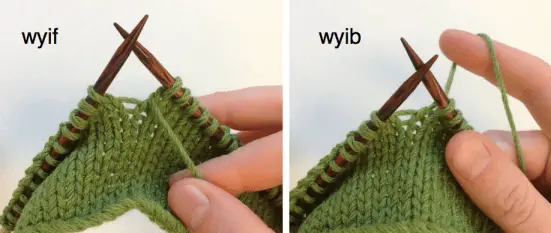WYIF in Knitting – What does wyif mean in knitting?
Jump To:
When you first start knitting, the vast amount of abbreviations and jargon will be confusing. However, as your experience grows, this all becomes second nature to comprehend! What does wyif mean in knitting? Let’s take a look at two common ones: WYIF & WYIB, which stand for “With Yarn In Front” and “With Yarn in Back” respectively. Check out what does STS mean in knitting.

What Does WYIF Mean in Knitting?
Knitting has its own language that takes some getting used to. The term WYIF refers to the relative position of your working yarn in relation to what you are knitting, and it simply means with yarn facing forward. It may seem simple enough, but this is one definition worth learning if you want an easy transition into becoming a knitter yourself.
When you see WYIF used in conjunction with other abbreviations such as sl1WYIF or sl1Pwyif, they both mean the same thing. Sl 1 wyif means to slip one purlwise with yarn in front of your work (you can also find this written as sl1pwyif). You may also see it written “slip wyof,” which means that before slipping a stitch, make sure your working yarn is behind all projects and then move forward into position for knitting the next two stitches together through back loops.
How Do You WYIF?
Whether you are knitting or purling will affect how your WYIF is formed and how it looks.
To slip one stitch with yarn in front while knitting:
- Take the working yarn and move it to the front.
- Slip the next stitch purlwise from the left needle to the right needle.
- Now move the working yarn to the back and continue knitting.
To slip one stitch with yarn in front while purling:
- Leave the working yarn in front if in the correct position.
- Slip one stitch purlwise from the left to right needle.
What Does WYIB Mean in Knitting?
The knitting abbreviation WYIB is the opposite of its counterpart, WYIF. This refers to where you are in relation to your work and working yarn when knitting.
How Do You WYIB?
To slip one stitch with yarn in back while knitting:
- With yarn in the back while knitting, slip the next stitch purlwise from left to right.
- Remember not to move the working yarn.
To slip one stitch with yarn in the back while purling:
- With yarn in the front, move the yarn to the back.
- Slip the next stitch purlwise from the left needle to the right needle.
- Move the yarn back in front again and continue purling.
These abbreviations are simple and easy to understand. After practicing them a few times, you’ll have no problems following along as you read these in your patterns.
How do you do WYIF in knitting?
What is sl1 WYIF?
“sl1 wyif” is an abbreviation which means slip 1 stitch purl-wise with yarn in front. Because the “sl1 wyif” is worked at the end of the row, that slipped stitch creates a selvedge edge which gives the scarf a neat, finished edge.
How do you knit in sl3 WYIF?
How do you knit sl1 WYIF?
If you are knitting: the working yarn is in the back as you knit each stitch. To sl1 wyif (slip 1 stitch with yarn in front) you need to move your working yarn to the front (i.e.: the side facing you) between the needles. Slip the next stitch purlwise from the LH to the RH needle.
What does pm mean in knitting?
Place Marker Place Marker (pm) As you continue to knit, you will come across this marker on every row or round thereafter. When you come back around to it, move or slip the marker from the left to right needle.
What does slip one Purlwise mean in knitting?
How do you yarn over Purlwise?
What is the purl stitch?
Definition of purl stitch : a knitting stitch usually made with the yarn at the front of the work by inserting the right needle into the front of a loop on the left needle from the right, catching the yarn with the right needle, and bringing it through to form a new loop — compare knit stitch.
What does knit 2 together mean?
A basic stitch in knitting, K2Tog (or knit two together) means exactly what it sounds like: knit two stitches together. It’s used often in knitting patterns and is one of the most common ways to decrease the number of stitches on your needle.
